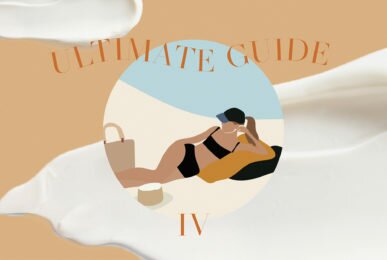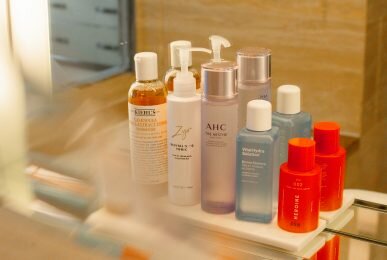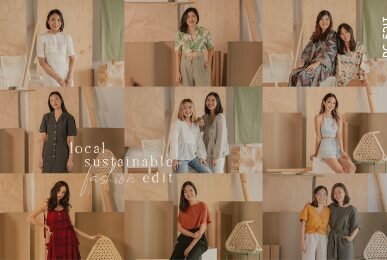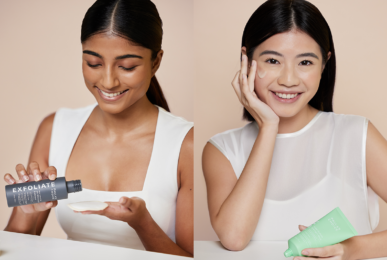In the second part of our Ultimate Sunscreen Guide (read Part I here), let’s dive deeper into the two main categories of sunscreens: Chemical VS. Physical. We’ll examine their differences — the good, bad and whether there really is a “better” choice. Sounds technical? I promise you it won’t be, so keep reading!
The Low Down: Physical VS. Chemical Sunscreens
Yup, they’re not all one and the same! Find out the key differences between chemical and physical sunscreens so you can make a more informed choice on what works best for you.
Physical Sunscreens


Physical sunscreens contain active mineral ingredients such as titanium dioxide and zinc oxide. They protect us from the sun by sitting atop of our skin to deflect and scatter UV rays (just like a shield would). Hence, the term “sunblock” technically refers to physical sunscreens — not all kinds of sunscreen in general!
The Good
- No waiting time after applying physical sunscreen (unlike chemical ones, read more about them below).
- Physical sunscreens are less likely to irritate/sting skin, making them more suitable for dermatitis-prone and sensitive skin types.
- Since physical sunscreens block UV rays and deflect heat, they are more compatible with rosacea-skin because they do not increase internal skin temperature.
- Their formulas are less likely to clog-pores, which makes them better for those with acne concerns.
The Not-So-Good
- Physical sunscreens tend to be less resistant to water, perspiration and being rubbed off, so more frequent reapplication is needed. This is especially since the occlusive film created by physical sunscreens can cause one to perspire more, which in turn degrades the sunscreen faster!
- Physical sunscreens may also leave a white cast on skin, particularly on deeper skin tones.
- They tend to have thicker and chalkier formulas, which may not be as comfortable or suitable for everyday wear (especially beneath makeup).
- Along with their heavier textures, physical sunscreens must be applied liberally and accurately, or UV rays can still enter through molecular “gaps” in the sunblock.
- While physical sunscreens are less pore-clogging, the texture makes it harder for them to be removed — which could still lead to clogged pores and breakouts.
Chemical Sunscreens


Chemical sunscreens contain organic (carbon-based) compounds, such as Oxybenzone, Octinoxate, Avobenzone and Octorylene*. These organic compounds cause a chemical reaction, which is how chemical sunscreens protect us from the sun. Essentially, chemical sunscreens convert UV rays into heat, then release this heat from your skin to prevent UV rays from being absorbed.
(*Confused? You don’t necessarily need to know what these compounds are! The key takeaway is — any sunscreen that contains any of these compounds are chemical ones.)
The Good
- Chemical sunscreens tend to have more fluid, thinner formulas that make them more wearable (particularly under makeup).
- They also leave less of a white cast; many claim to be traceless.
- Their formulas make it easy for skin-treating/protecting ingredients to be added, which could enhance the functionality of chemical sunscreens. Most multi-tasking sunscreens (such as those with tone-up or whitening properties) tend to be chemical ones.
The Not-So-Good
- As mentioned in Part I of this guide, chemical sunscreens require you to wait 10 minutes after application to set and become effective.
- They may be unsuitable for dermatitis-prone/sensitive skin because the addition of multiple ingredients to achieve broad-spectrum UVA/UVB protection can cause irritation and stinging.
- Chemical sunscreens are not recommended for rosacea-prone skin since the chemical process of converting UV rays to heat can exacerbate flushing.
- Similarly, some experts believe that this increase in internal skin temperature caused by chemical sunscreens could worsen existing brown spots/skin discolouration.
- As chemical sunscreen formulas can be pore-clogging, they are less compatible with acne-prone skin.
- Since chemical sunscreens are absorbed, there has been ongoing debate about how safe their synthetic ingredients really are. Some popular key ingredients in chemical sunscreens like oxybenzone and octinoxate have been linked to negative environmental and human health impacts — including the possibility of causing cell-damage.*
*There are tons of information regarding the safety of chemical sunscreen ingredients. But remember, not all reports are done neutrally or fairly. Want to find out more? Consider reading EWG’s report on the toxicity of active ingredients in sunscreen here. For a scientific analysis of “dangerous” sunscreen claims, read this highly informative article from Science Becomes Her.
Physical VS. Chemical Sunscreens: Is There A “Better” Option?
The short answer is, not really.
It all depends on what feels comfortable on your skin, based on your skin type and preferences. Physical and chemical sunscreens won’t work the same for everyone. In fact, they might not even work the same across different settings!
A personal example: After using chemical sunscreens for years, a sudden onset of adult eczema in 2017 saw me switching to a mild, physical sunscreen for two years. However, as I wear makeup pretty often and dance actively, I found that the thicker texture of physical sunscreens didn’t quite work for my lifestyle. So when the eczema on my face cleared last year, I gradually switched back to chemical sunscreens. I still keep a tube of physical sunscreen just in case, for days when my skin feels sensitive, or whenever my eczema flares up.
The Real Bad Option
While there may not be a clear “better” option, there is a bad option. That is, no sunscreen at all. It’s safe to say that the sun still poses the greatest danger.
Remember, wearing sunscreen is always better than no sunscreen at all. The important thing is to weigh your SPF options and pick one that best suits you, that you’ll want to wear everyday!
—
Stay tuned to Part III and IV of our Ultimate Sunscreen Guide for the low-down on SPF you need to know!
Take care,
Melisa














